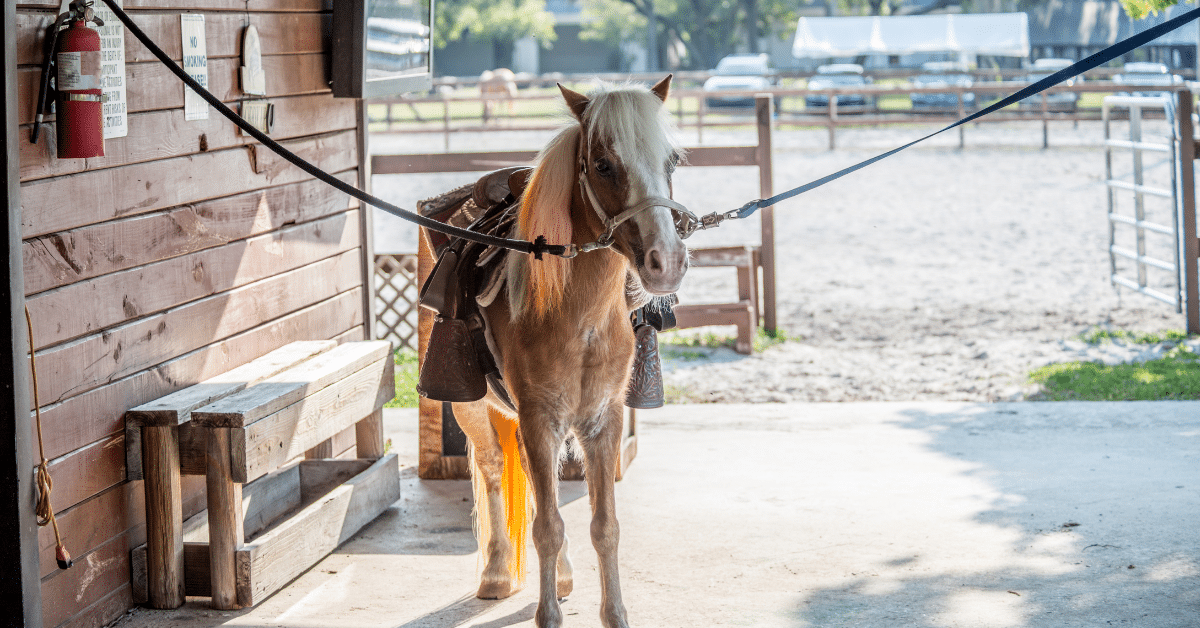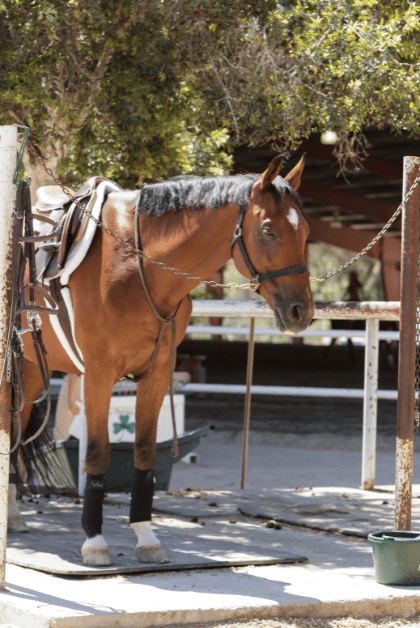What is a Cross Tie?
 A traditional cross tie for horses is simply two ties, each attached to the side of a wall or two posts. The two ties, which are most commonly made of rope or strap, are secured to the horse on their halter. The purpose of cross tying horses is to keep the horse centered, stable, and safe.
A traditional cross tie for horses is simply two ties, each attached to the side of a wall or two posts. The two ties, which are most commonly made of rope or strap, are secured to the horse on their halter. The purpose of cross tying horses is to keep the horse centered, stable, and safe.
Why is Cross Tying Horses Necessary?
Cross ties for horses exist in order to safely limit the movement of a horse. The most common scenarios in which cross ties for horses are used is when a horse is being groomed, or being treated by a vet. Some people think that cross tying horses is inhumane, and let’s be clear that it absolutely can be. When a horse is tied up incorrectly by using a poor setup or the wrong accessories, it could lead to injuries.
What Do I Use to Cross Tie a Horse?
There are a lot of materials used in cross tie straps such as nylon, polyester, bungee, and even leather. However, the material is not nearly as important as the flexibility of the strap. It’s important to remember when choosing a cross tie strap for your horse that it has some give to it. Although cross tying a horse is meant to keep the horse’s movement limited, it’s never meant to completely restrict their movement. Even when a horse is tied up, they should be comfortable and be able to raise and lower their head. If you’re looking for a good option for a horse cross tie strap, we really like this set of 2 available on Amazon.
Cross Tying a Horse: How to Set Up
Step 1. Designate an Area to Cross Tie Your Horse
When it comes to finding an area in your barn to set up the cross ties, you’ll need to find or install two sturdy posts or walls. The ideal distance between the two tie points is at least 10 feet apart. The reason for this is to keep both you and your horse safe in the event that they startle while you’re working on them. You will need enough room to back away from the horse, and the horse needs to be far enough away from the posts or walls so that they do not injure themselves.
Step 2: Install Tie Rings
Tie rings for horses should be installed on the wall or post at a high level. It’s important that the horse tie ring is located at a height that is taller than the withers of your tallest horse. A good rule of thumb is to install the tie rings 6 inches above your tallest horse’s withers. We recommend using blocker tie rings. These tie rings are designed to keep your horse safe as they provide support, but they also provide slack in the event that your horse startles. These horse tie rings are available to purchase on Amazon.
Step 3: Ensure a Breakaway System
In the event of your horse panicking, a cross tie setup could harm them without a proper breakaway system. The most preferred method for cross tie breakaway is to put some type of clip on your horse’s halter rather than on the post or wall. This ensures that in any type of unpredicted event, the cross tie is broken away from your horse and remains intact with the wall, rather than following a panicked horse. It also prevents a wall breakaway cross tie from swinging or snapping back and injuring your horse.
Step 4: Tie Up Your Horse
Once you have set up your cross tying area and ensured that it is safe, tying up your horse is fairly simple. You attach your cross tie straps to the tie rings, and pull them down at an angle to attach to your horse’s halter. The straps may need to be adjusted depending on the height of your horse. The most important thing is to make sure that your horse seems comfortable, calm, and is not completely restricted in their movement.
Here is a great video that demonstrates how to cross tie a horse correctly:
What to AVOID When Cross Tying Horses

-
DON’T leave your horse tied up for extended periods of time.
-
DON’T cross tie a horse without a breakaway system in place.
-
DON’T cross tie your horse in an area that has uneven or slippery flooring.
-
DON’T cross tie your horse in a heavily cluttered area.
-
DON’T tie your horse to anything that isn’t firmly secured.
-
DON’T leave a horse unattended while cross tied.
-
DON’T cross tie to a bit or bridle - only the halter.
-
DON’T cross tie a horse at a connection point that’s lower than its withers - this could cause their legs to get caught.
-
DON’T tie a horse in an area with loud noises, small children, or anything else that could cause them to be spooked easily.
Tying a Horse to a Horse Trailer
We get asked pretty often about how to tie a horse to a horse trailer. The reality is that while the inside of horse trailers are designed to be horse-friendly, the exterior normally is not. Here at Double D Trailers, we do everything that we can to make the exterior of horse trailers as safe as possible, but there is always a chance of injury. In addition to the risk of harm for your horse, there is also a chance that your trailer could be damaged. However, there are alternatives to keep your horse and your horse trailer protected in the event that they need to be tied.
Learn more in our article here: Trailer Exteriors are NOT ‘Horse Proof’: Tying Alternatives to Protect Your Horse and Trailer
When it comes to cross tying a horse, when tied properly, it’s normally safe for both horses and handlers. If you’re ever in doubt, don’t be afraid to spend some extra time practicing quick release / breakaway measures, or ask for help.
Frequently Asked Questions
Are cross ties for horses safe?
Properly cross tying a horse is an excellent way to keep both horse and handler safe in scenarios like grooming or vet treatment. Cross ties allow for horses to remain secure, calm, stable.
How far apart should cross ties be placed?
The recommended distance between cross tie posts or walls is 10 feet. The absolute MINIMUM distance is 8 feet. Anything smaller than that is dangerous for both you and your horse.
How tight should cross ties be?
Cross ties should be tight enough to keep your horse secured and supported, without being too tight as to prevent your horse from being able to move their head.

